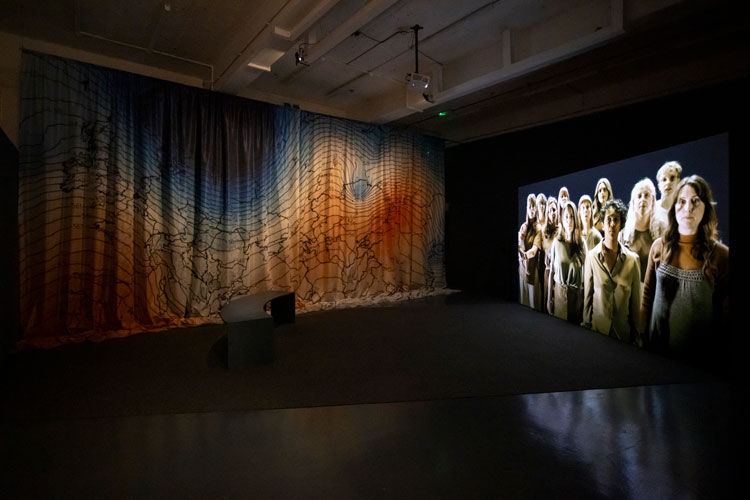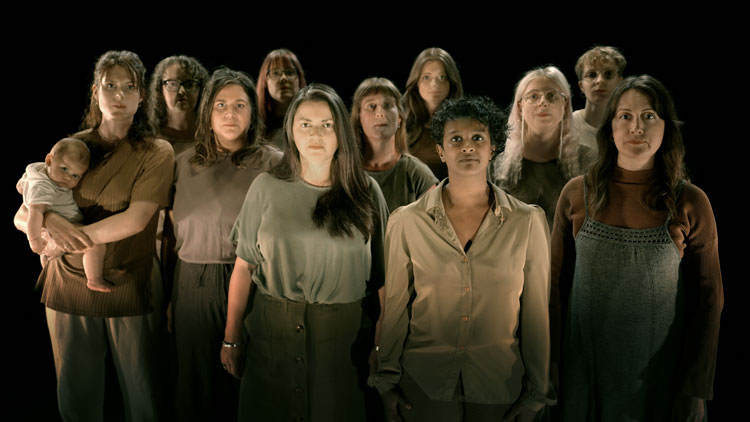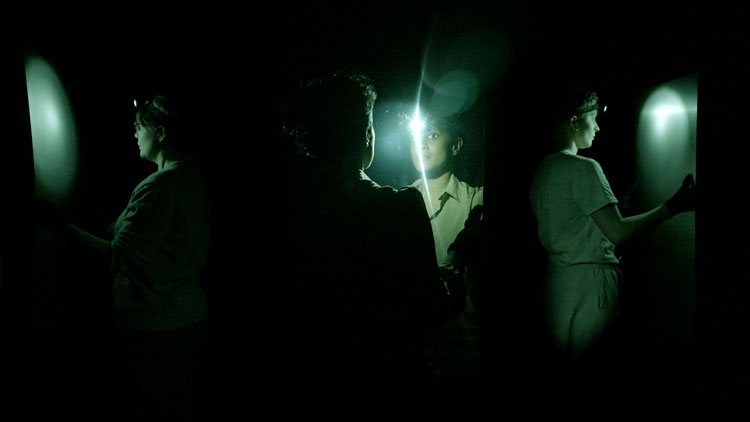Walking into the Showroom from the street on an unusually hot summer day turns out to be the perfect setting for Mikhail Karikis’ new work, Songs for the Storm to Come, literally – it is dark and cool in the large ground floor space – and symbolically – the film is a call to action against climate change. A group of members from the Manchester-based SHE cooperative choir for women and non-binary people is shown singing, chanting and moving; a smaller tableau shows two women studying and discussing maps. The maps, based on climate modelling data, predict rising sea levels in London and the wider UK in the year 2050 and, as expected, they don’t look promising. Alongside the film are placards displaying the maps as well as photographs of a climate protest in London, and a large printed textile from Karikis’s series of thermal maps showing annual record-breaking heatwaves since the start of the Covid-19 pandemic.

Mikhail Karikis: Songs for the Storm to Come, installation view, The Showroom, London, 2025. Photo: Cesare De Giglio.
This is not the first time Karikis has addressed ecological concerns in his work – they were at the forefront of his previous works No Ordinary Protest and Ferocious Love – but the current work feels more urgent and more direct. This is partly because Karikis didn’t set his subjects in an outdoor setting, but against a stark, black background; but also because the words chanted by the group leave no room for doubt: “Stop the War” and “Start transition now”.
Despite this firm call to action, there is enough poetry to leave the viewer enchanted, not distressed. The flags woven in protest are light and lyrical, performing their own magical dance; there are quotes from philosophers’ writing, ranging from Indigenous leader and activist Ailton Krenak’s Ideas to Postpone the End of the World and Timothy Morton’s All Art is Ecologicalto Cameroonian political theorist Achille Mbembe’s The Universal Right to Breathe.

Mikhail Karikis: Songs for the Storm to Come, 2024. Video still, courtesy and copyright of the artist.
Sound has always been at the heart of Karikis’s work. He uses it in the way that a sculptor uses their material: modelling, moulding, breaking and stretching it. The voice is just one instrument in Karikis’ rich arsenal; there are additional sounds made by the body such as clapping and stamping, and sounds made by functional objects such as whistles. But most prominent in Songs for the Storm to Come are the sounds of breathing – an act so ordinary and seamless and yet so central to our lives on Earth. The women are shown gasping and moving backwards as if thrown by a force larger than them, and it is a chilling and powerful metaphor for all living creatures, at risk of being slowly erased from this planet if we don’t take our care for it seriously.

Mikhail Karikis: Songs for the Storm to Come, 2024. Video still, courtesy and copyright of the artist.
A Greek-born artist living between London and Lisbon, Karikis has long combined a place-based, collaborative process with an insistence on his participants’ expression of their imagination and emotions through sound. He is the recipient of the Paul Hamlyn Award 2024 and a finalist in the London Derek Jarman Award 2016 and 2019, and in the DAIWA Art Prize in 2015. Solo exhibitions include a current mid-career retrospective Voices, Communities, Ecologiesat the Kunstmuseum St Gallen (until 27 July) a mid-career retrospective at the National Museum of Contemporary Art Athens (EMST) in 2023, and exhibitions at Tate Liverpool, Tate St Ives and Whitechapel Gallery. Karikis has led music performances at Royal Opera House and the Barbican, and created solo albums as well as collaborating on albums with Björk and DJ Spooky.
Mikhail Karikis, Songs for the Storm to Come
The Showroom, London
27 June – 16 August 2025
Interview by SABINE CASPARIE
Filmed and edited by MARTIN KENNEDY